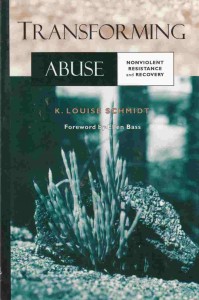Transforming Abuse: Nonviolent Resistance and Recovery by K. Louise Schmidt uses a synthesis of feminist theory and nonviolent practice as the springboard for understanding violence toward women and children, our place in the system, which perpetuates the violence, and suggestions for societal change through personal action. Schmidt offers us a vision of a non-enemy ethic that begins with practicing nonviolence in our daily lives and extending this into our families and our communities.
Schmidt begins her look with a horrifying account of the violence that affects us all. Armed with statistics and the words of experts in this field, she paints a grim picture of the reality of violence towards women and children and the current social silence surrounding it. Schmidt believes “…all violence is the result of great alienation from the fragility and preciousness of all our lives. Life, this great gift, is forgotten in a plethora of greed, individualism and fear.” (23) Reminding us of the distinction between anger as a feeling and violence as an action, she writes that we cause pain in others because we disconnect ourselves from the pain in our own lives. Rather than allowing the feeling to transform into violence, anger and hurt can be our greatest resource for the energy to create change.
Drawing upon the tenets of feminism and the practice of nonviolence, Schmidt weaves a worldview that allows us to stop being victims while refusing to be violent. Feminism “…supports the development of ideas and alternatives that respect the diversity and commonality of humankind…” (27) while nonviolent practices embody a heartfelt respect for others through a non-revenge ethic. The key to positive change is restoring the connection between our body and our soul, and developing a healthy relationship with our selves in order to end the inner war. This will, in turn, open our eyes to a mindfulness of others and the world. Schmidt encourages us to examine our personal lives, alter our thoughts and behavior, and consciously extend our peace and love to those around us.
Once we recognize the interdependence of all life and refuse to bend to the binary logic of “us vs. them” or “good vs. bad”, true change is possible as we learn to practice consensus by building alliances, focusing on win-win solutions, and recognizing diversity as a resource rather than an obstacle. We will reinforce the idea that “our real opponent is not the offender; it is the system that creates the offender and arms him or her with the authority to oppress.” (89)
Schmidt also offers suggestions for generating this change in our families and our communities. She believes the family is a sanctuary, an environment where each member feels freedom, love, and a sense of belonging. “Nonviolent child-rearing practices offer a child loving acceptance based on gentle leading and the expression of joy in their presence in our lives.” (106) Nonviolence in our communities begins with the realization that “we are all members of one another, and when the health of one member suffers, the health of the whole body is lowered.” (112)
In her final chapters, Schmidt develops a vision of creative justice based on deep democracy—the belief that there is a place for all members within our community. Transforming violence requires the efforts of all segments and all levels of society—from the grass-roots groups to the criminal justice system; although, as Schmidt points out, our criminal justice system currently persecutes the offender as well as the victim, which halts any progress towards reformation for the offender and recovery for the victim. Ultimately, it is the nonviolent actions of each citizen that will transform our society from its preoccupation with the enemy ethic and allow for cooperative partnerships with every member of the community including the abusers.
In our fight to end violence against women, we must remember the principles of nonviolence in order to practice our belief that all life is precious. With exercises for individuals, small groups or workshops as well as an extensive list of resources for further research, Transforming Abuse offers an alternative method of converting our anger and hurt into positive energy for both internal and external change.
Book review originally published in Working Together, Summer 1996 ( the newsletter for the Center for the Prevention of Sexual and Domestic Violence, Seattle, WA)
